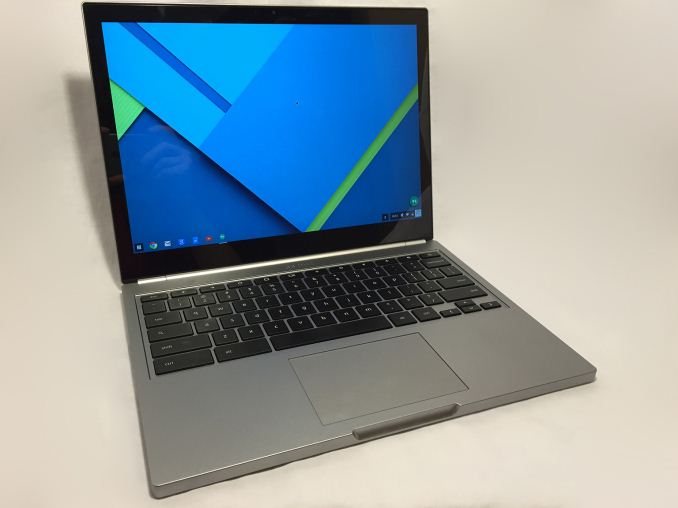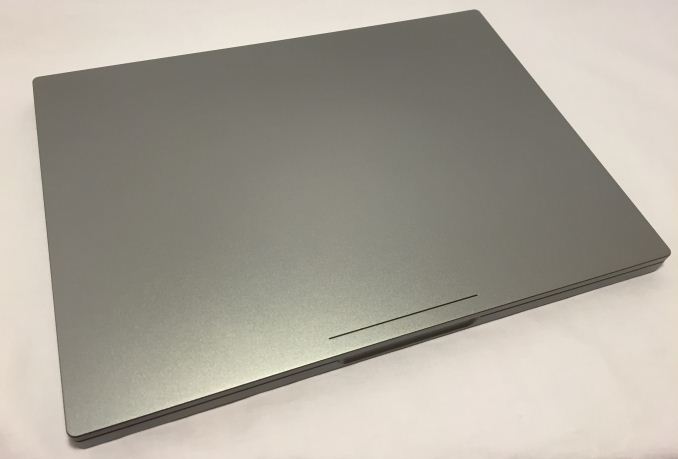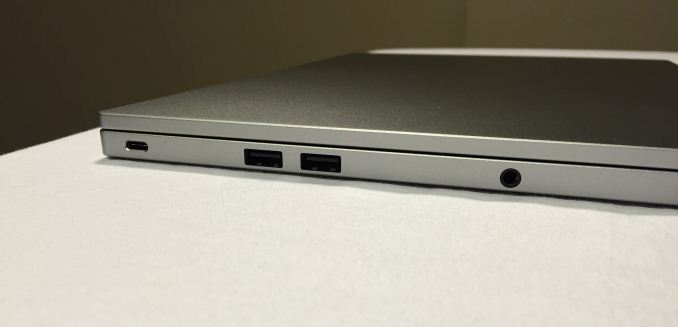The Chromebook Pixel (2015) Review
by Brandon Chester on March 16, 2015 8:00 AM EST- Posted in
- Laptops
- Chrome OS
- Chromebook
- Chromebook Pixel

Google's Chrome OS has always been similar to Microsoft Windows in how one company provides the operating system for many different manufacturers to use on their own devices. But two years ago, Google decided to create a Chromebook which was solely Google branded and designed. Although Chromebooks typically aim at the inexpensive part of the laptop market, this Google branded Chromebook had specifications that put it in line with high end Ultrabooks, and an equally high price tag. It was the original Chromebook Pixel, and its name referred to its 2560x1700 IPS display. At 239ppi it had the highest pixel density of any laptop in the world when it was released, and the rest of its specs were also impressive. In our original review of it, we concluded that it was an impressive laptop, but that its starting price of $1299 was quite a barrier to entry. In addition Chrome OS was more limited at that time than it is today.
That brings us to the new Chromebook Pixel which was released just last week. At first glance, you would be hard pressed to tell the difference between this new model and the old one. It has a similar high resolution display, and the same aluminum body with flat edges. But a look at the sides of the chassis will reveal a pair of highly versatile USB Type-C ports, and a figurative look inside will show one of Intel's new Broadwell CPUs which enables high performance and stellar battery life. Before we dive into the new Chromebook Pixel, I've compared it with the original Pixel from 2013 in the chart below.
| Chromebook Pixel (2013) | Chromebook Pixel (2015) | Chromebook Pixel LS | |
| Dimensions | 11.72 x 8.84 x 0.64" (297.7 x 224.5 x 16.3mm) | ||
| Mass | 3.35 lbs (1.52kg) | ||
| CPU | Core i5-3337U (2 cores + HT) | Core i5-5200U (2 cores + HT) | Core i7-5500U (2 cores + HT) |
| L3 Cache | 3MB | 3MB | 4MB |
| Base CPU Clock | 1.8GHz | 2.2GHz | 2.4GHz |
| Max CPU Turbo | 2.7GHz | 2.7GHz | 3.0GHz |
| GPU | Intel HD 4000 | Intel HD 5500 | Intel HD 5500 |
| System Memory | 4GB DDR3L-1600 | 8GB LPDDR3-1600 | 16GB LPDDR3-1600 |
| Storage | 32GB SSD | 32GB SSD | 64GB SSD |
| Display | 12.85" 2560x1700 IPS LCD | ||
| Battery | 59 Wh | ||
| Ports | 2 x USB 2.0, Mini DisplayPort, 3.5mm audio | 2 x USB Type-C, 2 x USB 3.0, 3.5mm audio, SD card | |
| Connectivity | 2x2 802.11a/b/g/n + BT 3.0 | 2x2 802.11a/b/g/n/ac + BT 4.0 | |
| Launch Price | $1299 | $999 | $1299 |
Some investigation into the Pixel's hardware reveals a few more details about it. The version sent by Google was the normal Intel i5 model, and although I don't expect the suppliers would be different for parts of the "Ludicrous Speed" model, it's still possible. In addition, parts like the RAM and SSD could be sourced from multiple vendors, although this is again unlikely due to the relatively small number of units that will be manufactured.
The original Pixel used a Sandisk iSSD, while this new Pixel uses an SSD made by Kingston. It's likely that it's still soldered to the motherboard which makes replacing or upgrading it impossible. Given that the Pixel can only be disassembled using suction cups and a great deal of force I'm not able to actually look inside to check. In addition, the i5 model of the Pixel uses two 4GB LPDDR3 modules which are manufactured by Samsung.
The chassis of the new Pixel is just as impressive as the previous model. The aluminum construction feels incredibly solid, and is heavy but not excessively so. When you first look at it, you'll notice that the device itself is slightly more square than other laptops, as a result of its 3:2 display. This square profile also extends to the sides and edges of the Pixel, which are as flat as can be. The top of the device also retains the LED light bar from the original model, which lights up in green, yellow, red, and blue colors and has a very Googley feel to it. Tapping twice on the top of the laptop will cause some of the LEDs on the light bar to turn on, and the color and number of LEDs gives you an approximation of how much battery life you have left. All these little details result in a really unique design, and its been clear since the original Pixel that Google wanted to create their own device instead of just carbon copying another laptop
Upon opening the Pixel, you'll be greeted by a uniquely shaped LCD display surrounded by a fairly thin bezel. Beneath it are the keyboard and touchpad, both of which felt great to use. The keyboard had a comfortable amount of key travel, very little movement back and forth, and large well spaced key caps that made typing a breeze. The keyboard also acts as the vent for the Pixel's fans, and the speakers are hidden underneath. Google uses sensors to detect when your hands are over the keys, and so the keyboard backlight is only on when you're typing. The touchpad is covered by a smooth piece of glass, and it was responsive and accurate in use, which is something that can't be said about many other laptops regardless of price. One small complaint I have is that Chrome OS doesn't seem to support pinch to zoom on the touchpad. If it does, I certainly couldn't find the option anywhere I looked.
That brings us back to the display, which is a 3:2 touch enabled IPS LCD. Chrome OS seemed reasonably responsive using the touchscreen, although much like on Android multi-touch gestures like pinch to zoom didn't track well to how your fingers were actually moving inward and outward. I don't think that the touchscreen is really a necessary input method on a laptop, and in my experience it's not comfortable in the slightest to hold your arm up and poke at your laptop display, but the option is there for users who desire it. Google has also improved the display hinge to reduce the bounce back of the display when touching it.
The sides of the pixel have all of the ports for expansion. Google clearly believes that users enjoy having ports on their laptops, and so each side of the Pixel has a USB 3.0 Type-C port, along with two USB 3.0 Type-A ports and an audio jack on the left side, and an SD card slot on the right side. Google provides several adapters that can be used to transform the Type-C ports to other existing interfaces, including HDMI, DisplayPort, and both female and male USB Type-A.
The build quality of the Chromebook Pixel certainly inspires a great deal of confidence in the rest of the machine, so lets continue our examination of the new Pixel with a look at the improvements Google has made to the display.













123 Comments
View All Comments
FITCamaro - Tuesday, March 17, 2015 - link
Apple is not innocent from hardware problems. They just started offering fixes for 2011-2013 Macbook Pros that have heat issues. I had an early 2011 MBP through work and had to get it fixed 4 times. I was on my third physical machine until I was upgraded to a new 2014 MBP. It definitely runs cooler but also doesn't have a dedicated GPU. And at 1920x1200 (the max supported effective resolution), the Iris Pro isn't powerful enough to properly drive all the animations so you get screen tearing just in swiping between desktops.mayank.gulia - Friday, May 15, 2015 - link
In a world of fanboys spewing venom at each other, its refreshing to read such a balanced view on a gadget.One device (or platform) doesn't have to be SHIT to justify your choice in buying the competitor.
I have a Macbook pro at home, a Windows Laptop for work and an old Ubuntu Dell Machine that refuses to die. That works as my download machine. And I am still going to buy the Pixel 2. Because I am heavily vested in the Google eco system. And it would be fun to check out a new toy.
I will buy the pixel 2. Not because its "the most magical and innovative" device in the world that will keep me young forever or cure ALS or bankrupt Microsoft and Apple. I will buy it.. because I can.
Well said Mohawke.
sligett - Tuesday, March 17, 2015 - link
Wow. Are you Sam Biddle, or did you just steal his Gizmodo article from 2013? In either case, couldn't you at least update and correct it? Your point #2 doesn't have any facts in it, but all your other points are full of errors.MamiyaOtaru - Tuesday, March 17, 2015 - link
I really don't like widescreen. I'm tempted by this solely for the aspect ratio. I used to use 5:4 on the desktop before moving to 4:3 to get an IPS. This is still less square than that, but nowhere near the awful 16:9 junk everything else has nowadaysHackerForHire - Sunday, March 22, 2015 - link
>Chrome OS will give you internet, basic word processing through Google Docs, video via YouTube, and the rest of Google's web services including a free as in freedom lifetime direct hotlink to the NSAThat's funny. According to this NSA slide Microsoft was volunteering data to the NSA way back in 2007.
http://en.wikipedia.org/wiki/PRISM_%28surveillance...
In fact, Microsoft was the very first company to sign up.
Spunjji - Wednesday, April 8, 2015 - link
3:2, a square? You think that a rectangle 50% longer on one axis is a square? Perhaps you would like to think about that some more.This system doesn't have HD4000 graphics either. Please fact check before you write more overly-long posts.
The thing is, you have a reasonable point about the pointlessness of an expensive Chromebook. You just fouled it up with bile and nonsense.
BrandonVillatuya - Tuesday, September 15, 2015 - link
But here's the thing when you buy a chromebook pixel, you pay for what you aren't getting. If you don't want more than 64gb of internal storage if you don't want a ton of extrebloated features you don't need, you are actually paying for an experience that is slower and less efficient than that of a Chromebook. What if you don't use native apps that much and what if you aren't too worried about the NSA because literally it makes no difference what laptop you use. With the Chromebook pixel you get better battery life for the light os, a great display, two USB c ports, and it can run Linux. So basically everything you hate about it doesn't matter.ThorOlsen - Monday, March 16, 2015 - link
I'd say most programmers would love to own it. The vertical display depth is fantastic for programming. Google could easily charge more and it'd still be an attractive buy. The keyboard-layout (US/UK only) is the only thing stopping me from ordering one.boeush - Monday, March 16, 2015 - link
I'm a programmer... I wouldn't want to work on a 13" screen. I wouldn't even wish that on my worst enemy...sorten - Tuesday, March 17, 2015 - link
The only aspect of the Pixel that would be appreciated by programmers is the aspect ratio of the display. ChromeOS would limit you to web based dev tools, which are improving but are not a real option in most dev shops unless you're doing web dev only (html, css, javascript).